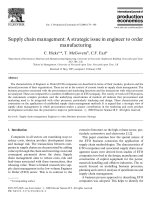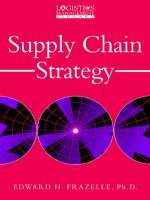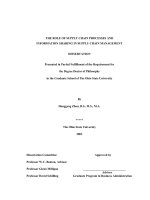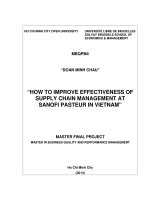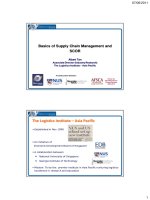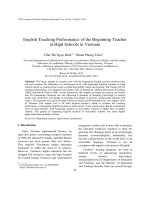How to improve effectiveness of supply chain management at sanofi pastour in vietnam
Bạn đang xem bản rút gọn của tài liệu. Xem và tải ngay bản đầy đủ của tài liệu tại đây (2.35 MB, 63 trang )
HO CHI MINH CITY OPEN UNIVERSITY
UNIVERSITÉ LIBRE DE BRUXELLES
SOLVAY BRUSSELS SCHOOL OF
ECONOMICS & MANAGEMENT
MBQPM4
“DOAN MINH CHAU”
“HOW TO IMPROVE EFFECTIVENESS OF
SUPPLY CHAIN MANAGEMENT AT
SANOFI PASTEUR IN VIETNAM”
MASTER FINAL PROJECT
MASTER IN BUSINESS QUALITY AND PERFORMANCE MANAGEMENT
Ho Chi Minh City
(2014)
STATEMENT OF AUTHENTICATION
I, Doan Minh Chau, hereby declare that this assignment is prepared by myself in
completion of Master in Quality and Business Performance Management Program
(2012-2014) in Ho Chi Minh City, and that I have not submitted this material, either in
whole or in part, for a degree at this or any other institution.
ACKNOWLEDGEMENT
I would like to thank Mrs. Vo Thi Phuong, Chief Representative of Sanofi Pasteur S.A
Representative office in Ho Chi Minh city, who gives a lot of support for my
continuous learning and allows me to access to company’s data and reports to complete
this case study, and thank to my colleagues who provide me the relevant information
and data mentioned in this assignment.
I would like to send my gratitude to Pro. Jacques Martin for guiding and advising me
on structure and presentation of discussion topic, my gratitude is also sent to all
professors who gave lectures for MBQPM 4 intake as knowledge transferred and
experience learned from them help me to complete this assignment effectively.
I will keep a good memory of our classmates MBQPM4, with all interactions, sharing
knowledge moments we have passed together where I learned a lot from their
experiences which are also very useful to my final report.
And lastly, a big thank to my family for their patience, love and encouraging during my
quality journey with Solvay since 2012 till the completion of this assignment.
5
TABLE OF CONTENTS
• Presentation of subject
• The importance of the subject
• Structure of presentation
Part I. ANALYSIS OF SUPPLY CHAIN OPERATIONS:
CHAPTER 1: COMPANY BACKGROUND
1. Vision/ Mission / Organization
2. SWOT/ PESLT /PORTER DIAMOND analysis
10
16-20
CHAPTER 2: STRUCTURE OF SUPPLY CHAIN
1. From product to delivery process:
1.1 Demand Forecast
1.2 Sourcing and Purchasing
1.3 Manufacturing
1.4 Quality control
1.5 Distribution
23
23
25
26
28
28
2. Critical issues identification & analysis:
31
2.1 Shortage of product / Failure to deliver on time
31
2.2 Root-cause identification and analysis
2.2.1 Production capacity
2.2.2 Manufacturing process
2.2.3 Supplier
2.2.4 Quality control
2.2.5 Distribution
2.2.6 Regulatory
31
35
35
36
36
37
38
6
Part II. IMPROVING SUPPLY CHAIN OPERATIONS:
CHAPTER 1: INCREASING THE EFFECTIVENESS OF
SUPPLY CHAIN OPERATIONS
1. Production capacity
41
2. Manufacturing
41
3. Sourcing / purchasing
42
4. Quality control
42
5. Forecast Management
43
6. Distribution
43
CHAPTER 2: IMPROVING DOWNSTREAM PROCESS
1. Supply and Demand Forecast management
47
2. Customer Relationship Management
53
3. Regulatory Affairs Management
55
4. Distribution capability improvement
57
PART III.CONCLUSION
58
7
LIST OF ABBREVIATIONS
1 GPEI:
2 GAVI:
3 NGO:
4 WHO:
5 PAHO:
6 UNICEF:
7 EPI:
8 JAICA:
9 GMP:
10 SAP:
11FuturMaster:
12 HQ:
13 D&S:
14 IO:
15 FDA:
16 MTS:
17 MTO:
18 NICVB:
19 DAV:
20 CIF:
21 PMC:
Global Polio Eradication Initiative
Global Alliance for Vaccine and Immunization
Non-governmental Organization
World Health Organization
Pan American Health Organization
United Nations Children's Fund
Expanded Program on Immunization
Japan International Cooperation Agency
Good Manufacturing Practices
German company which is the market leader in supplying ERP
software, systems and training.
Software for Forecasting, Planning and Supply Chain Optimization.
Headquarter /Global office of Sanofi Pasteur S.A in Lyon, France
Demand and Supply
Industrial Operations
Food and Drug Administration
Make to Stock
Make to Order
National Institute for Control of Vaccine and Biological of Vietnam
Drug Administration Division /Ministry of Health of Vietnam
Cost, Insurance and Freight
Preventive Medicine Center
8
LIST OF TABLES
Part I. ANALYSIS OF SUPPLY CHAIN OPERATIONS
Table 1.1: Organization chart of Sanofi Pasteur in Vietnam
Table 1.2: Distribution flow of vaccines in private and public market in Vietnam
Table 1.3: Vaccine Customers Mapping
Table 1.4: Vaccine’s public and private market 2005-2012
Table 1.5: Vaccine market 2012 in Vietnam
Table 1.6: Long range planning 2012-2017
Table 1.7: Vaccine manufacturing timeline
Table 1.8: Forecast is the first step in supply chain process flow
Table 1.9: Make to Stock Model
Table 1.10: Vaccine Manufacturing Process
Table 1.11: Distribution of vaccine mapping
Table 1.12: Vaccine temperature monitoring
Table 1.13: Product allocation planning
Table 1.14: List of SP products in supply constraint in 2013
Table 1.15: Ishikawa diagram for root cause analysis
Part II. IMPROVING SUPPLY CHAIN OPERATIONS
Table 2.1: Risk assessment flow chart
Table 2.2: Pareto chart on causes of vaccine storage
Table 2.3: Moving –average forecast calculated over 4 months’ period
Table 2.4: Stock coverage end of month
Table 2.5: Root cause identification list
Table 2.6: Rolling forecast structure
Table 2.7: Demand Model Reporting 2012-2013
Table 2.8: Product technical complaint tracking
Table 2.9: Rationalization for direct importation model
Table 2.10: SP Operations Key enablers
Table 2.11: SP Balance Scorecard
9
INTRODUCTION
In recent years, most of business has to compete actively in a very fast changing
environment to increase customer satisfaction and maximize profitability. Supply chain
is a key activity within the company to maintain competitive advantage. According to
Jacoby (2009-42), for many manufacturing firms that are threatened by low-cost
competition, supply chain management has become a competitive necessity. The
effectiveness of supply chain management will help the organization to compete in a
dynamic business environment which is combined by highly predictable and
completely un-predictable factors. Slack, Chambers and Johnston (2007-157) observed
that the better the service the operation can provide to its customers, the better will be
its potential to attract customer and therefore generate revenue.
This assignment aims to discuss the supply chain operations at Sanofi Pasteur S.A., a
vaccine manufacturer, to see how important the effective supply chain management
contributes to the overall performance of the company. It is important to analyze
existing constraints that impact the supply chain operations and to suggest solutions to
improve the effectiveness of the supply chain management in order to increase the
quality of service provided to Customers, to maximize profitability and to maintain
competitive advantage in both private and public health sector in Vietnam market.
This assignment is divided into 2 parts: the First part introduces an overview on Sanofi
Pasteur S.A, business context in which the company operates as well as critical issues
faced by the company which give negative impact on customer satisfaction, following
by root-cause analysis. The Second part proposes possible solutions and prioritized
action plans to improve the effectiveness of the supply chain management, with strong
focus on downstream processes to continuously improve and innovate to stay
competitive in the market.
An overview on supply chain operations at Sanofi Pasteur S.A.is described hereafter in
the First part of this assignment. It covers the company mission, internal, external
factors driving its business objectives in Vietnam market; the supply chain structure
covering production cycle and distribution of vaccine in the market as well as critical
issues faced by the company which give negative impact on customer satisfaction,
following by root-cause analysis.
10
Part I. ANALYSIS OF SUPPLY CHAIN OPERATIONS
CHAPTER 1: COMPANY BACKGROUND
1. Vision/ Mission/Organization
Sanofi Pasteur S.A. (hereafter referred as to “SP”) is a French company who discovers,
develops, produces and distributes human vaccine and biological products. SP is the
largest company entirely dedicated to vaccines. The company provides more than one
billion doses of vaccine each year, making it possible to immunize more than 500
million people across the globe. With a broad and balanced presence in emerging
markets, SP employed approximately 105 000 employees in 110 countries. The 2009
net sales of Global performance are 29.3 billion Euros with 6.3% increase compared to
2008 on a reported basis.
A world leader in human vaccine industry, SP offers the broadest range of vaccines
protecting against 20 infectious diseases caused by viral diseases such as: yellow fever,
mumps, poliomyelitis, measles, rubella, influenza, hepatitis A and B, rabies, Japanese
encephalitis, chicken pox and by bacteria diseases such as pertussis, diphtheria,
haemophilus influenzae typ b infections, meningococcal meningitis, pneumococcal
infections, tetanus, tuberculosis, typhoid, cholera…
Every day, the company invests more than 1 million Euros in research and
development of innovated products such as dengue fever, Japanese encephalitis and
new pediatric combo vaccines. SP has entered in partnership with GPEI1, GAVI
Alliance2, NGOs3 and international institutions including WHO4, PAHO5, UNICEF6,
International Red Cross and others partners for active global disease prevention
program.
With the Vision “A world in which no one suffers or dies from a vaccine preventable
disease”, SP commits to protect and improve human health worldwide by:
• Providing superior, innovated vaccines for the prevention and treatment of
diseases.
• Playing an active role in the immunization community to maximize
vaccination.
11
Marketed in Vietnam since 1992, SP plays an active role in the immunization
community to increase public health awareness and makes innovated vaccines
available for the market needs. In the last 3 years, SP supplied to Vietnam market more
than 2 million doses of vaccines, annual turnover increased from 12.8 Mio USD in
2011 to 15.3 Mio USD in 2013. The turnover is expected to be triple in 2016 by
introducing new vaccines to the market.
In Vietnam, SP has its representative office registered and operated in Ho Chi Minh
city with main activities:
- Carry clinical studies for registration purpose
- Register and renew market authorization
- Promotion marketed products.
The representative office is structured in form of business unit within Sanofi Group in
Vietnam with 4 main cross functions: Sales/ Supply/ Marketing/ Medical with flat
organization chart shown in Table 1.1 below.
BU - Vaccines
Business Unit Director
Sales manager
15
Supply chain
manager
Group Product
manager
Medical
manager
1
Table 1.1 Organization chart of Sanofi Pasteur in Vietnam
Source: Sanofi Pasteur Vietnam
3
12
The representative office cannot carry direct commercial activities in Vietnam as
regulated by Laws thus the distribution of SP products is handled through local
distribution network. Foreign companies do not have the right to import directly
vaccines to Vietnam yet, thus SP has entered into exclusive distribution contracts with
Vietnamese distributors, one for the North Vietnam (Redpharco Ltd.) and the other for
the Center and the South of Vietnam (May Cosmedic JSC) to distribute vaccines to
hospitals, preventive medicine centers for privates sales or to EPI7 importer for public
sales.
Table 1.2 below describes distribution flows to import vaccines to Vietnam market.
Table 1.2 Distribution flows of vaccines in private and public market in Vietnam
Source: Sanofi Pasteur Vietnam
The health system in Vietnam is quite complex and is divided into 2 separate segments:
Treatment and Prevention. Below picture 1.3 describes the vaccine universe through
the existing health system. In Treatment segment, only 21% of public hospitals open
their own vaccination room, while 70% of vaccination centers rooms are belonging to
public Preventive segment organizations such at Preventive Medicine Centers (PMC)
13
at national, regional and provincial level. The rest of 9% is located in private hospitals
and Key Account companies.
Vaccine universe
Table 1.3 Vaccine Customers Mapping
Source: Sanofi Pasteur Vietnam
Vaccine products are classified to be used in Prevention segment, and the vaccine
market is divided in private and public market.
• Public market provides free vaccine for primary vaccination to children up to 12
months of age. The product used in the EPI is mostly sponsored by GAVI,
UNICEF or local producer. SP has dated its long cooperation with Vietnam EPI
since 2004 for the supply of typhois and measles vaccine.
Although the sales of vaccine to EPI program decreased in 2012 as local producer
can produce measles vaccine, but there still have room for improvement as large
number of vaccine needed to be included in Public program such as Inactivated
Polio vaccine, Flu, Pneumococcal Conjugated vaccine, Human Papilloma virus
and Dengue.
Table 1.4 below shows the repartition of SP turnover between public and private
segment from 2005 to 2012.
14
Table 1.4 Vaccine’s public and private market 2005-2012
Source: Sanofi Pasteur S.A.
•
Private market is mainly supplied by international manufacturers as local
manufacturer cannot produce yet high quality and innovated vaccines. The end
users must pay out of their pocket for these vaccines. The economic development
generates emergence of a growing mid and upper class boosting the demand for
Private market vaccine consumption. The private market is driven by innovated
products such as Human Papilloma Virus, Rotavirus and combination based
vaccines for children… SP maximized its sales over the last 3 years despite a gap
in the product portfolio.
In Asia, SP ambition is to lead the vaccine market in 2016 with innovated products
such as Japanese encephalitis and dengue fever vaccines which are still under clinical
trials phases in Vietnam. The production of vaccine as biological products is a very
complex and difficult process that Vietnamese manufacturers cannot be able to produce
innovated and combination based vaccines yet due to failure in quality aspect. This
favorable factor attracts international investment thus foreign manufacturers can enter
the vaccine market easily and be able to growth their market share in a very dynamic
market.
Below Table 1.5 reflects the repartition of 2012 market share between main players in
Vietnam vaccine market, in which SP holds 21% of the market share, its main
15
competitor is GSK with 24% market share, followed by Novartis and Merck at 16%
market share, and the rest are for local and Indian players:
Table 1.5: Vaccine market 2012 in Vietnam
Source: Sanofi Pasteur S.A.
SP ambition is to reach the sales out to the market in 2017 to 47 Mio USD (Table 1.6)
with successful introduction of innovated products in both public and private market.
Table 1.6: Long range planning 2012-2017
Source: Sanofi Pasteur S.A.
16
The following analysis on internal, external factors such as SWOT/ PESTLE/
PORTER DIAMOND will give an overview on SP position in the dynamic and fast
changing vaccine market in Vietnam and help to understand the business strategies,
objectives applied by SP to well adapt to changes and gain sustainably competitive in
the market.
2. SWOT/ PESLTE / PORTER DIAMOND ANALYSIS
2.1 SWOT analysis
STRENGHS
ADVANTAGES/ DISAVANTAGES
1. Branded products & French
manufacturing. Leader in rabies market.
Products with European origin have
the advantage to gain tender at
hospital / health centers.
2. Good efficacy & safety vaccine profile.
Wide range portfolio offered for infant,
toddler and adult.
Doctor and parents prefer to choose
high quality and safety vaccine due
to safety vaccination issue.
Satisfy the vaccination need of
different clusters.
3. Long term cooperation, partnership with
Health Authorities, Healthcare Centers,
Health Organizations (WHO, GAVI,
NGOs …)
Access to market intelligence
management and facilitate business
strategies deployment.
WEAKNESS
1. Trade activity in Vietnam is limited due
to limited scope of representative office
activities.
Distribution is managed by local
distributors thus the control over
promotion campaign, sales policies,
and quality of product is always
challenging.
2. Products portfolio is not competitive
due to lack of innovated products.
Innovation products must be
introduced as soon as possible in
Vietnam to regain market share.
17
OPPORTUNITIES
1. High endemic country of rabies,
encephalitis, measles, rubella…
diseases.
High demand to prevent against
diseases to reduce health, economic
burden.
2. Economic growth generates emergence
of middle and upper class with high
income.
High demand of vaccination of
quality product.
3. Expanded Program for Immunization
(EPI) needs to reach recommendation of
WHO on Vietnam immunization
planning.
4. New Law will permit foreign companies
to import directly in future
Opportunity to develop and growth
in public market
Improve distribution network
capability / new importation model
THREATS
1. Rabies market is matured.
Challenge to expand & grow
2. Competitors launched similar products
with new technology.
Replace current SP product, seek for
immediate innovation
3. Discount policy offered by competitors.
Loose market shares
18
2.2 PESLT Analysis
POLITICAL
1. Stable politic environment
2. Zero tax exemption for imported
vaccine/biological products
3. Strict price control by MOH8
4. International Health organization has
strong influence on public health sector
such as WHO, JAICA9, UNICEF…
Long-term cooperation with
MOH/WHO on vaccination
guidelines and enrollment in health
insurance package.
Difficult to revise the price for sales
in market
ECONOMIC
1. GDP per capita is 2000 USD
2. GDP growth 2008-2013: 5.5%
GDP growth forecast for 2014: 6%
Due to limited budget on healthcare,
the vaccines out of primary
vaccination are not listed Public
Health insurance package yet
3. Inflation rate in 2013: 6%
4. Healthcare spending: 6.6% GDP.
SOCIAL
1. Population: 90 M inhabitants. Urban
population is only 31% vs 69% for
rural population. Birth cohort : 1.5M
babies/ year
Possibility to expand market in rural
areas where vaccines are still not yet
affordable in some poor provinces
2. Low awareness in vaccination against
diseases, people focus on treatment
only.
Possibility to cooperate with EPI to
provide education & training on
safety vaccination to the healthcare
workers in provinces, as well as
vaccination awareness to lay public.
3. Lack of government resource & fund to
follow-up and monitor safety and good
practices in EPI vaccination program.
19
TECHNOLOGICAL
1. Chinese investment on new vaccine
plant construction in Vietnam: from
2013-2015 for pharmaceutical
production, from 2016 onwards:
vaccine production.
2. Fast using of internet in nationwide
Possibility to cooperate with them to
implement local packaging of our
vaccines in the future.
Possibility to virtually approach
Customers.
ENVIRONMENTAL
1. Intensive competition among rabies
players in the market.
2. Innovated mumps and pneumococcal
vaccine will be introduced by
competitors in 2014.
Accelerate the registration of SP new
profile of rabies vaccine to gain
competitive advantage.
Lose market share of our two
equivalent products
LEGAL
1. Direct import right shall be grant to
foreign companies.
Improve distribution network by
direct importation model
2. Tender classification issued by MOH
gives favorable condition for innovated
products.
Must accelerate the registration of
innovated products to win tenders for
maximizing sales in private segment
3. Unclear guidance on clinical trial of
new vaccine; complicated registration
requirements and processes to renew
product license.
Impact on the acceleration of
registration process of new products
4. Strict control on price of vaccine in
private market.
5. More requirement on local safety test
of imported vaccine
Subject to intense regulation
requirements
Time consuming impact on
availability of vaccine in the market
20
2.3 PORTER’ S DIAMOND
FACTOR CONDITIONS
1. Rabies vaccine was first innovated and
manufactured by Louis Pasteur in France
over more than a century. Branded
products thanks to late dated history of
rabies vaccine manufacturer.
Competitive advantage: we are the
first who develop cell culture rabies
vaccines which is safer and more
effective in comparison with old
brain tissue vaccines from
competitors. Increase customer’s
truth & satisfaction.
2. Main production sites located in Europe,
US, Canada… meets GMP10 standards.
Rabies vaccine is WHO pre-qualified
product.
Good criteria to gain tenders at
Hospitals. Meet regulatory demands
for register and renew products.
3. Strength in geographical diversity of SP
production facilities. SP has major
production facilities in France, Italy, US,
Canada, China, India, Thailand,
Argentina, and soon in Mexico.
Help to optimize the production
capacities to meet anticipated
demands for current and new
vaccines.
4. SP must continue to invest in state-ofthe-art technologies to meet market
growing demand.
Only innovation is imperative to
sustain SP leader position and
expand the market
DEMAND CONDITIONS
1. Middle and upper class of high income
patients can afford now to high quality
vaccines as they are afraid of the serious
adverse reactions caused by old
generation vaccines.
Market expansion in Asia where there
is high demand of quality vaccine
products.
21
RELATED AND SUPPORTING
INDUSTRIES
1. With implementation of subsidiaries in
most South East Asia countries, SP
processes a wide range of distribution
network.
2. Existing regional advisory boards in
public health such as rabies, flu…and
existing local network of Pasteur
Institute in Vietnam.
Help to secure vaccines just in time in
case of shortage.
Facilitate knowledge management in
healthcare community: Update and
sharing best local practices and
scientific information among Asian
countries to provide practical data
base on diseases treatment.
3. Local factories in the North and the
Center produce local vaccines for EPI
program.
Opportunity to cooperate in local
packaging project to reduce
distribution cost.
4. International logistic company operates
effectively in pharmaceutical field.
Opportunity to cooperate to enhance
distribution network in case of
business expansion.
FIRM STRATEGY, STRUCTURE AND
RIVALRY
1. Leader in rabies market. Commit to
supply safe & efficacy products to
prevent and reduce the fatal rate caused
by rabies disease.
Competitive advantage in term of
quality of product & branding image
of Louis Pasteur.
2. Organization focuses on Customers.
Strong Leadership management.
Devoted Sales team to promote SP
products. Strong Support Functions team
(Marketing, Supply, Medical)
Flat organization facilitating quick
reporting and decision making
process. Limited headcount
challenges sales expansion in remote
provinces.
22
FIRM STRATEGY, STRUCTURE AND
RIVALRY (continued)
Double loop learning to solve issue in
the short term to defend the market
share. Prioritize regulatory objectives
to faster the registration of new
vaccines to regain the leader position
in Vietnam market.
3. Strong competition by Indian & Chinese
competitor (02 competitors with 02
substitute products with very low &
attractive price)
COMPARISION BETWEEN 2 APPROACHES
S.W.O.T
This approach helps to draw 2 strategies:
DIAMOND
This approach analyses in more details of
the business environment by looking
through the whole business processes. It
helps us to maximize our capability and
resources to develop 2 strategies:
1. Strategy No 1:
1. Strategy No 1:
Focus on business excellence and
Develop and expand of new market to
optimize organization effectiveness to
generate more sales.
accelerate clinical trial and faster
registration of new vaccines to re-gain the
market leader position and secure
competitive advantage.
1. Strategy No 2:
Develop customer relationship
management to maintain loyalty and
seek for partnership opportunity.
2. Strategy No 2:
Develop and maintain partnership with
Vietnam EPI to generate recommendation
on vaccination schedules to sustain SP
growth in both private and public market.
23
In the Chapter 2 below, the structure of SP supply chain operations will provide a
common understanding on several steps to be involved in vaccine supply chain
operations as well as associated challenge which impacts the availability of vaccine in
the market.
CHAPTER 2: STRUCTURE OF SUPPLY CHAIN OPERATIONS
1. From product to delivery process:
Vaccine development is very different from drug. Vaccines are biological products
made from living microorganisms with very complex manufacturing processes. In
order to have the product available to be distributed to the market, the supply chain
structure involves many steps through initial sales forecasting, material and
components procurement planning, production organization, quality test control, batch
release by health authorities to packaging, transportation, distribution and finally
quality stability, adverse reaction follow-up after distribution.
We will go through four main steps of vaccine supply chain “Forecast-ProduceControl-Deliver” to see how vaccine is produced and distributed to the end-Users.
1.1 Demand Forecast
Vaccine are biological products which are used for prevention against diseases, not for
treatment thus the sales forecast is usually based on historical sales data and marketing
planning in each country and plays a trigger role for industrial operations in order to
avoid over or under production.
Lead time for vaccine production is 24 months, below picture presents the
manufacturing timelines of a batch of vaccine: for example the products which were
sold in 2009 have been started to be produced in 2007, and in 2009 we started
producing bulk for 2011 demand, then finished products were filled and packed in
2010 to ensure the stock for sales in 2011.
Below picture 1.7 describes the manufacturing timelines which requires accurate
forecast to drive production operations.
24
2007
2008
Bulk
2009
2009
2010
2011
Sales
2009
Sales
2010
Sales
2011
Pack.
2009
Pack.
2010
Pack.
2011
Filling
2009
Filling
2010
Filling
2011
Bulk
2010
Bulk
2011
Table 1.7 Vaccine manufacturing timeline
Source: Sanofi Pasteur International
Sales forecast and demand planning are processed through internet based system with
SAP11 and FuturMaster12 tools. These tools help to collect and interchange electronic
data between global operations and its 140 subsidiaries. Sales forecast, inventory
levels, shelf-life data for 650 SKUs collected from subsidiaries are consolidated and
validated at corporate level to balance the demand and the supply forecast. The control
of these data will help to identify critical situation such as write-off, stock-out… to
better monitor the distribution planning.
Lead time to deliver a confirmed order takes 6 months. Most of product life cycle is 36
months, except flu and serum against rabies is only 12 months. A horizon forecast of
36 months must be anticipated to commit an order to be delivered on time to the
market. Forecast is the very first step in supply chain process to monitor the balance of
supply and demand within this 36 months horizon.
Demand
Sanofi
Pasteur
Production
Commercial
SCM
Team
Lyon
Country
Client
Supply
Table 1.8: Forecast is the first step in supply chain process flow
Source: Sanofi Pasteur International
25
On monthly basis, Headquarter (HQ)13 and its subsidiary hold the Demand and Supply
(D&S) 14 meeting to capture and validate all the needs of the customer in relevant
market. The sales forecasted the actual month (N) will be analyzed in comparison with
data registered in the previous month (N-1), any variance must be documented with
inputs from sales & marketing to rationalize the Demand validation at Industrial
Operations level.
These inputs are very important for Industrial Operations (IO)15to plan the procurement
of active ingredients and immediate products. IO needs to take decision to pack the
semi-finished product or not 6 months in advance to respond to a firm Demand from
Customers. There is little flexibility to modify the Demand once it is communicated to
IO. A firm Demand cannot be cancelled in the horizon of 3 months.
Additional demand which is not validated during D&S meeting will not be responded
except there is buffer which is unused from other markets. However, there is also high
uncertainty on the outputs released as quality of biological products is trigger to the
quality process control. The release of one single batch is not highly committed as
planning due to these constraints. As a consequence, inputs from downstream part play
a very important role to ensure outputs from upstream part along the supply chain.
The next sourcing and purchasing part must take also inputs from forecast to establish
and monitor the procurement planning appropriately.
1.2 Sourcing and Purchasing
As earlier mentioned, the sales forecast plays trigger role to the procurement planning
of active ingredients and immediate products. At corporate level, SP has centralized all
procurement and purchasing activities and established global and long term sourcing
and purchasing contracts with its suppliers, sub-contractors in Europe and Asia Pacific
to control the cost, quality and delivery time of critical items such as material,
components… for manufacturing process.
The internet-based purchasing information and enterprise resource planning tools are
applied to plan and control the procurement process to ensure just in time delivery of
these materials. Accuracy forecast will help SP to benefit low cost of purchased
materials and balance the demand and supply components, immediate products for
production process and reduce storage and overhead cost to control this stock.
The supplier’s factory is subject for quality inspection to ensure the compliance with
GMP and FDA16 requirement on quality aspects. Every single process must be
26
validated as from regulatory perspective; any kind of vaccine for human use needs a
market authorization in relevant market destination. Thus strict terms and conditions on
selection criteria are also applied for these suppliers in order to strictly control the
suppliers’ outputs to meet regulatory requirements on quality. Different requirements
from regulatory aspect for each country describe the complexity of manufacturing
process.
1.3 Manufacturing
With more than 13 manufacturing sites worldwide, the main sites are based in France,
Canada and US. Recently, SP has expanded three more sites in India, China and
Mexico to better serve these potential emerging markets need.
Depending on the type of vaccine, it takes 6-24 months to produce a single batch. The
production cycles are much longer than the traditional pharmaceuticals industry due to
the need for quality control of biological products and around 70% of manufacturing
process is taken up by quality control.
SP applies make to stock (MTS)17 model to produce vaccine for mass distribution of
standard packaging products in Europe, Latin America, South Africa, Asia
Pacific…and make to order (MTO)18 (below Table 1.9) to produce specific orders for
public market in Canada, USA and Mexico, especially pandemic flu for US
government.
Table 1.9: Make to Stock Model
Source: Sanofi Pasteur International

